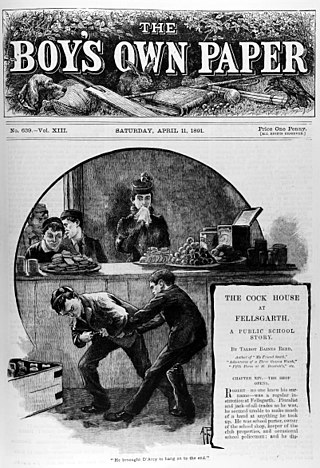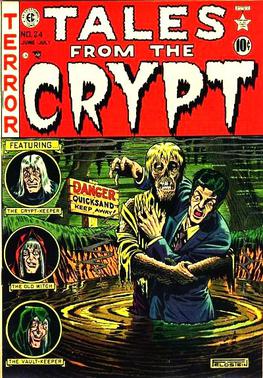
Marvel Comics is an American comic book publisher and the property of The Walt Disney Company since December 31, 2009.

Children's literature or juvenile literature includes stories, books, magazines, and poems that are created for children. Modern children's literature is classified in two different ways: genre or the intended age of the reader.
A British comic is a periodical published in the United Kingdom that contains comic strips. It is generally referred to as a comic or a comic magazine, and historically as a comic paper.

Western fiction is a genre of literature set in the American Old West frontier and typically set from the late eighteenth to the late nineteenth century. Well-known writers of Western fiction include Zane Grey from the early 20th century and Louis L'Amour from the mid-20th century. The genre peaked around the early 1960s, largely due to the popularity of televised Westerns such as Bonanza. Readership began to drop off in the mid- to late 1970s and reached a new low in the 2000s. Most bookstores, outside a few west American states, only carry a small number of Western fiction books.

Penny dreadfuls were cheap popular serial literature produced during the 19th century in the United Kingdom. The pejorative term is roughly interchangeable with penny horrible, penny awful, and penny blood. The term typically referred to a story published in weekly parts of 8 to 16 pages, each costing one penny. The subject matter of these stories was typically sensational, focusing on the exploits of detectives, criminals, or supernatural entities. First published in the 1830s, penny dreadfuls featured characters such as Sweeney Todd, Dick Turpin, Varney the Vampire, and Spring-heeled Jack.

Fantasy literature is literature set in an imaginary universe, often but not always without any locations, events, or people from the real world. Magic, the supernatural and magical creatures are common in many of these imaginary worlds. Fantasy literature may be directed at both children and adults.

"Spidey Super Stories" is a live-action, recurring skit on the original version of the Children's Television Workshop series The Electric Company.
The Amalgamated Press (AP) was a British newspaper and magazine publishing company founded by journalist and entrepreneur Alfred Harmsworth (1865–1922) in 1901, gathering his many publishing ventures together under one banner. At one point the largest publishing company in the world, AP employed writers such as Arthur Mee, John Alexander Hammerton, Edwy Searles Brooks, and Charles Hamilton. Its subsidiary, the Educational Book Company, published The Harmsworth Self-Educator, The Children's Encyclopædia, and Harmsworth's Universal Encyclopaedia. The company's newspapers included the Daily Mail, the Daily Mirror, The Evening News, The Observer, and The Times. At its height, AP published over 70 magazines and operated three large printing works and paper mills in South London.

Elements of the supernatural and the fantastic were an element of literature from its beginning. The modern genre is distinguished from tales and folklore which contain fantastic elements, first by the acknowledged fictitious nature of the work, and second by the naming of an author. Works in which the marvels were not necessarily believed, or only half-believed, such as the European romances of chivalry and the tales of the Arabian Nights, slowly evolved into works with such traits. Authors like George MacDonald (1824–1905) created the first explicitly fantastic works.

Adventure fiction is a type of fiction that usually presents danger, or gives the reader a sense of excitement. Some adventure fiction also satisfies the literary definition of romance fiction.
A story paper is a periodical publication similar to a literary magazine, but featuring illustrations and text stories, and aimed towards children and teenagers. Also known in Britain as "boys' weeklies", story papers were phenomenally popular before the outbreak of the Second World War.
David Anthony Kraft was an American comic book writer, publisher, and critic. He was primarily known for his long-running journal of interviews and criticism, Comics Interview, as well as for work for Marvel Comics in the late 1970s and early 1980s.

The Union Jack was a British story paper for children of the late 19th and early 20th centuries. There were two story papers called Union Jack. The first appeared in the 1880s but was only very short-lived. The name was then used by Alfred Harmsworth in 1894 for a new halfpenny story paper intended as a companion to the successful Halfpenny Marvel.

Magazines intended for boys fall into one of three classifications. These are comics which tell the story by means of strip cartoons; story papers which have several short stories; and pulp magazines which have a single, but complete, novella in them. The latter were not for the younger child and were often detective or western in content and were generally greater in cost. Several titles were published monthly whereas the other two categories were more frequent.

Horror comics are comic books, graphic novels, black-and-white comics magazines, and manga focusing on horror fiction. In the US market, horror comic books reached a peak in the late 1940s through the mid-1950s, when concern over content and the imposition of the self-censorship Comics Code Authority contributed to the demise of many titles and the toning down of others. Black-and-white horror-comics magazines, which did not fall under the Code, flourished from the mid-1960s through the early 1980s from a variety of publishers. Mainstream American color comic books experienced a horror resurgence in the 1970s, following a loosening of the Code. While the genre has had greater and lesser periods of popularity, it occupies a firm niche in comics as of the 2010s.

The Halfpenny Yellow is the first postage stamp issued by the Crown Colony of Malta. Depicting Queen Victoria, it was only valid for local postage and it was originally issued on 1 December 1860. It was the only stamp issued by Malta for two and a half decades, and during this period various reprints were made with differences in colour shade, perforation and watermark. When control of Malta's postal service was transferred to the island's colonial government on 1 January 1885, the stamp was withdrawn and it was replaced by a set of definitive stamps.

Alicia Munroe is a fictional character from the BBC medical drama Casualty, played by Chelsea Halfpenny. She first appears in the series thirty episode "Cradle to Grave", broadcast on 19 September 2015. The character is introduced as an F2 doctor for a workplace bullying storyline with registrar Lily Chao, appearing for a stint of eight episodes. Alicia is characterised as bright, bubbly and a try-hard, making her appear naive. Despite this, Alicia is a brilliant doctor who always does more than is acceptable for her patients. Alicia's backstory states that she has grown up in Newcastle where she attended medical school, but recently moved to Holby.

Nelson Lee is a fictional detective who featured in the Amalgamated Press papers over a 40-year run. Created in 1894 by Maxwell Scott he appeared in various publications including The Halfpenny Marvel, Pluck, The Boys' Friend, Boy’s Realm, The Boys' Herald and the Union Jack In 1915 he was given his own story-paper series, The Nelson Lee Library, which ran until 1933.

Henry Thomas (Harry) Blyth (1852–1898) was a British writer who also wrote under the pen-name Hal Meredith. Blyth was born in Greenwich, London. He wrote for many of Alfred Harmsworth's papers of the 1890s, and is mostly remembered for creating detective Sexton Blake.

The Nelson Lee Library was a story paper of the first third of the 20th century, published by Amalgamated Press. It featured the adventures of private detective Nelson Lee and his boy assistant Nipper.
















